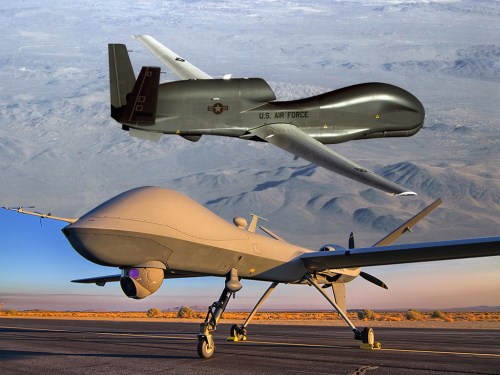
The US Air Force (USAF) has applied to the UK’s air regulator, the Civil Aviation Authority (CAA), to change airspace rules to allow RQ-4 Global Hawk and MQ-9 Reaper drones to fly from RAF Fairford in Gloucestershire.
The application for Global Hawk flights envisages them beginning in 2024. A recent update of the Reaper application states that while “the USAFE requirement for MALE RPAS at RAF Fairford remains” it is temporarily pausing the process while it reassesses how to comply with the current regulatory framework. While nominally described as an ‘RAF’ base, Fairford is wholly operated by the US Air Force.
Currently, drones that fly beyond visual line of sight (BVLOS) are not allowed to fly in the UK unless in segregated airspace. The USAF, through the Ministry of Defence (MoD), is seeking to put in place segregated corridors to allow these drones to transit through UK airspace. The RAF is currently going through the same process to enable it to fly the UK’s new ‘Protector’ armed drones from RAF Waddington in Lincolnshire. The USAF may be awaiting the CAA’s decision in this case (due very soon) before proceeding with its application to fly Reaper drones.
According to one document submitted to the CAA, the “working assumption” by the USAF is that the corridors would be activated 2-3 times per week but they are “exploring activation periods that exceed these assumption, both in frequency and time periods of utilisation.” The proposal is that the drones would take off and land overnight: “all activations will be between 1 hour after sunset and 1 hour before sunrise unless in extremis.”
Lack of oversight
If this change is agreed there will be very little chance of the public knowing when or where these US drones will be used operationally. While the government has said previously that combat operations from US bases in the UK are subject to “joint decision” in reality the government has little say or control over operations from US bases as the framework under which they operate – the 1951 Status of Forces Agreement – gives jurisdiction to the US, not the UK.
This is a very significant move. While the war in Ukraine will no doubt be at the forefront of people’s thinking in regard to this development, the US uses drones – surveillance and armed – to enable it undertake air strikes right across the globe, both in areas of armed conflict, but also beyond for so-called ‘targeted killings’. The UN, many individual states and international law experts have condemned the use of drones for these unlawful operations describing them as extrajudicial killings which undermine global peace and security. Read more







